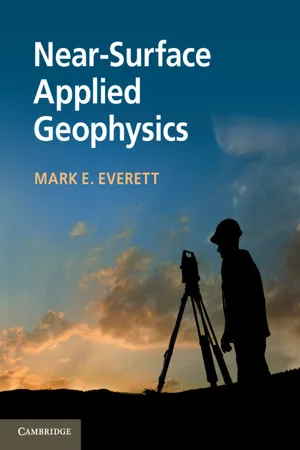Near-Surface Applied Geophysics
About this book
Just a few meters below the Earth's surface lie features of great importance, from geological faults which can produce devastating earthquakes, to lost archaeological treasures. This refreshing, up-to-date book explores the foundations of interpretation theory and the latest developments in near-surface techniques, used to complement traditional geophysical methods for deep-exploration targets. Clear but rigorous, the book explains theory and practice in simple physical terms, supported by intermediate-level mathematics. Techniques covered include magnetics, resistivity, seismic reflection and refraction, surface waves, induced polarization, self-potential, electromagnetic induction, ground-penetrating radar, magnetic resonance, interferometry, seismoelectric and more. Sections on data analysis and inverse theory are provided and chapters are illustrated by case studies, giving students and professionals the tools to plan, conduct and analyze a near-surface geophysical survey. This is an important textbook for advanced-undergraduate and graduate students in geophysics and a valuable reference for practising geophysicists, geologists, hydrologists, archaeologists, and civil and geotechnical engineers.
Frequently asked questions
- Essential is ideal for learners and professionals who enjoy exploring a wide range of subjects. Access the Essential Library with 800,000+ trusted titles and best-sellers across business, personal growth, and the humanities. Includes unlimited reading time and Standard Read Aloud voice.
- Complete: Perfect for advanced learners and researchers needing full, unrestricted access. Unlock 1.4M+ books across hundreds of subjects, including academic and specialized titles. The Complete Plan also includes advanced features like Premium Read Aloud and Research Assistant.
Please note we cannot support devices running on iOS 13 and Android 7 or earlier. Learn more about using the app.
Information
Table of contents
- Cover
- Contents
- Preface
- Acknowledgments
- 1 Introduction
- 2 Data analysis
- 3 Magnetics
- 4 Electrical resistivity method
- 5 Induced polarization and self-potential
- 6 Seismic reflection and refraction
- 7 Seismic surface-wave analysis
- 8 Electromagnetic induction
- 9 Ground-penetrating radar
- 10 Emerging techniques
- 11 Linear inversion
- 12 Non-linear inversion: local methods
- 13 Non-linear inversion: global methods
- Appendix A Shannon sampling theorem
- Appendix B Solution of Laplace´s equation in spherical coordinates
- Appendix C The linear tau-p transformation of seismic data
- Appendix D Horizontal loop over a conducting halfspace
- Appendix E Radar TE waveguide mode equations
- References
- Index
